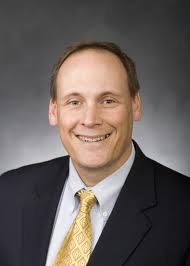 This is David Geddes, chair of the Institute for Public Relations Commission on Measurement and Evaluation.
This is David Geddes, chair of the Institute for Public Relations Commission on Measurement and Evaluation.
Today I am talking with Professor Brad Rawlins, chair of the communications department at Brigham Young University. Brad also is a member of the IPR Commission on Measurement and Evaluation.
Brad, could you give me a thumbnail of the public relations program at BYU?
The public relations program at BYU stresses strategic planning and execution through its emphasis in research, a multi-step planning matrix, writing, and development of communication tactics in traditional and new media. It was the first undergraduate program to be certified by PRSA and was named as one of the top 5 programs by PRWeek the last two years. We are really proud of our internship program that helps place students in all the major markets and with many top firms and companies.
I have worked with a few of your students as interns, and they were extremely well-prepared in research. How do you weave research, measurement, and evaluation into the undergraduate curriculum?
They learn the value of research in their very first public relations class, where they are taught the four stages of strategic planning, or RACE formula (Research, Action Planning, Communication, and Evaluation). They learn how to do background research before developing any kind of strategic plan in all of our classes. We also have a research course that works with a paying client to conduct formative research using qualitative interviews (in-depth or focus groups) and a quantitative survey (usually with a representative random sample). They then analyze the data using statistics software, write a report and give a presentation to the client. Students also learn about evaluation methods and we have some evaluation tools available in our student-run agency, but this is the hardest part to incorporate into the curriculum. We would love to have more clients with evaluation needs, or partner with measurement providers, to provide that experience for our students.
How can research training give students get a leg up in the job market and help them advance in their career?
I think the competitive edge it provides is the understanding of how research is the key to strategy. They have been converted to the gospel of data, and know that your gut instincts only get you so far. The reality is that most of the undergraduate students aren’t going to go into the research and measurement side of the profession, but they all come out knowing how it is conducted and should be able to ask smart questions of measurement providers or research departments. A handful of students catch the research bug and are intrigued by the creative challenges that research and measurement offer. I love to help these students find internships and jobs in this area of our profession.
Could you tell us a favorite anecdote about teaching research and measurement?
I don’t know if this is my favorite anecdote, but it’s something that happened last semester. We were working with a local hospital to research ways to increase in-patient services. Based on our initial interviews and background on the organization, we thought we understood the problem, and students were already discussing recommendations. We thought that the hospital’s location contributed to a serious lack of awareness. However, after conducting primary research through focus groups with local medical clinics and a representative survey of the community, we found out that awareness was very high, both of the hospital and its location. The real problem was a lack of communication with clinics that were not referring patients to the hospital. I love this example because I could see students really catch on to the value of research. They knew intellectually that it was important, but the “aha” moments that came from doing the research converted their hearts as well.




Hi,
This is pretty exhaustive and quite useful. Thanks for this post!!
Regards
Koustubh